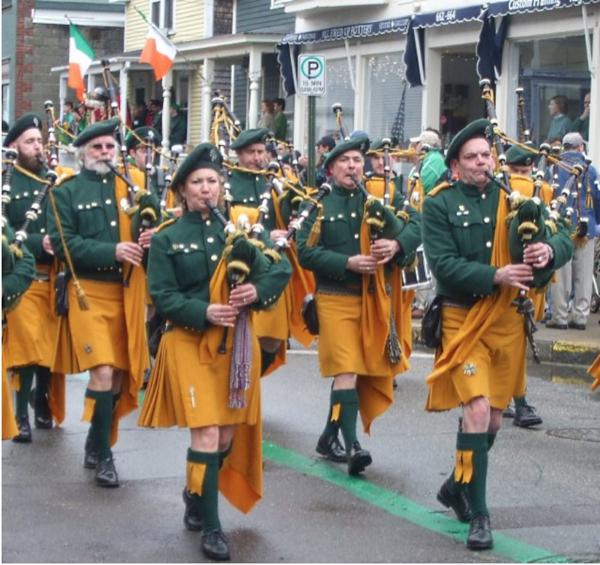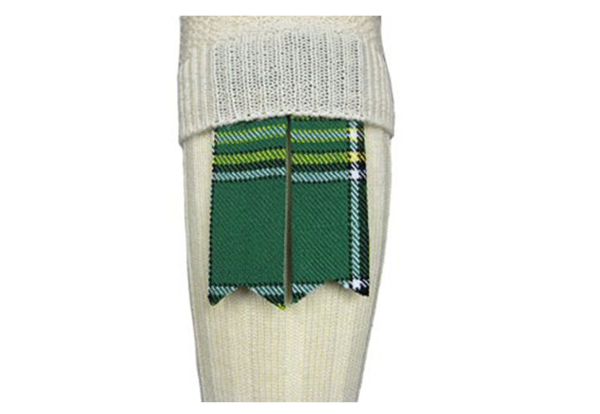Irish Kilts: An informative guide (updated Jan 2021)
For many of those outside of Ireland, they may only associate the kilt with the Scottish Highlands.
But kilts actually have a long history of being associated with Irish culture too. Whilst there are many differences between the kilts of the 2 countries, both countries wear their kilts as a symbol of pride and celebration of their Celtic heritage.
The exact origins of the Irish kilt is a subject which continues to be debated. Many people believed that the ‘Lein-croich’ was the first version, however this is not a traditional Irish kilt. The ‘Lein-croch’ is a long tunic, traditionally made from solid colour cloth, with black, saffron, and green.
Current evidence suggests that kilts that originated in the Scottish Highlands were worn from around the 1850’s by Irish nationalists. These were often solid coloured kilts, and their use was continued by Irish regiments serving in the British Army.
Similarly to how the ‘Feileadh Mor’ kilt was worn by Scottish troops on the battlefield, the Irish kilt was worn as protective clothing at this time.

Contrary to the believe that Irish kilts came into popularity in the 18th century, in 1956 a farmer uncovered a tartan piece of kilt fabric assumed to date back as early as 1590. They think the Irish kilt fabric was from an Irish warrior. This mystery is one which has yet to be fully unravelled!
In the late 19th and early 20th century, the kilt was re-adapted as a sign of Gaelic identity within Ireland. These Irish kilts can be seen in old photographs from the early 1900s, particularly as political and musical gatherings. It was only the rise in popularity of Riverdance that saw the abandonment of boy’s kilts in the world of Irish dancing.

The Irish national tartan was introduced during the rise of Irish nationalism, and has since been treated as a symbol of Gaelic tradition, in response to the ongoing anglicisation of Ireland.
The kilt most traditionally associated with Ireland is known as the Saffron Kilt. These were the first kind worn by the Irish military and are still the most widely worn today. The Saffron Kilt is mustard yellow in colour and often has shamrock appliques adorning the pleat.
Nowadays the Saffron kilt is normally made from woven cloth, but is designed to hang and feel exactly the same as if it were made from wool. Most designs are now fashioned with a pair of leather straps which can be adjusted around 10cm or so either way to allow for a comfortable fit.
If you think you could pull off one of these Irish kilts yourself, you can find out more about purchasing one HERE.
Irish Tartan
There are actually very few Irish family tartans, unlike Scotland where there are thousands. In Scotland your surname defines which tartan you associate with, as each family clan has their own tartan. Only a few of the most traditional Irish surnames can be today associated with their own tartans, for example Murphy, O’Neil and Fitzpatrick, which actually has two registered tartans.
However Irish tartans represent the counties or districts of Ireland. Most people from Ireland would choose to wear the tartan of the county or province where their family originated from. For example, if you hail from Cork, you would likely wear the Cork County Tartan.
There is a designated tartan for each of the four provinces of Ireland, Connacht, Leinster, Munster, and Ulster, as well as many others associated with smaller counties.
This variance in origins and meanings is probably the biggest differentiation between Scottish and Irish kilts. There is also an Irish National tartan which is often chosen by those who perhaps feel kinship with more than one area of Ireland, perhaps their parents hailed from different counties.
Celtic Titles Tartan
The tartan used by Celtic Titles is the All Ireland tartan, which is renowned for it’s beautiful colours and modern design. This tartan represents the whole of Ireland and this kilt is a welcome sight at any gathering of the Irish.
You can find some Irish kilts for sale with that tartan here
Irish Kilt Accessories – Ireland’s Traditional Clothing
There are a number of accessories often sported by a kilt clad person, but did you know that these could be the give away to whether you are looking at an Irish Kilt or not?
Sporran
These pockets attached to the front of the kilt are a traditional accessory in both Scotland and in Ireland, and there are no real distinct differences between the ones worn in each of the two countries. However it is possible to buy specifically designed Irish sporrans, complete with shamrocks and green detailing, should you wish to be particularly patriotic.
Crest
Whereas in Scotland it is a common tradition to wear your family crest pinned to your tartan, in Ireland this is seen much less often. Instead, Irish kilts are often either left bare or pinned with a shamrock crest.


The Brian Boru
This is a highly decorative double-breasted jacket with sweeping shawl lapels that are often made from a different fabric to the rest of the jacket, such as satin. It would normally be worn with a bow tie, waistcoat and Irish kilt, and would only be seen at more formal occasions.
The Kilkenny
This could still be seen at a formal event, but this is generally the jacket paired with the Irish kilt for more casual occasions. This should be worn with a standard collared shirt, waistcoat and necktie, and is often a shade of Irish green.
Socks
An example of the kind of sock which usually accompanies the Irish kilts.
The socks worn with the kilt are called kilt hose and are made from wool. Traditionally cream knee high socks with decorative ribbons to match your tartan would be worn with the Irish kilt. Although the Irish military actually wear black socks with their Saffron kilts.
Colours of kilt hose other than cream and black are sometimes worn, but are usually reserved for the casual events when you would be wearing your Day jacket.

Ghillie Brogues
These are a style of shoe traditionally worn with the kilt in both Ireland and Scotland. They are made of leather and have long ties to wrap around the calf. They can be difficult to learn to tie properly but it is more than worth it to ensure that your tapping feet can make the noise they are supposed to on the dance-floor!
So there you have it. Whilst Irish kilts may not be a custom as old as their Scottish counterparts, they are still a proud Irish custom, and definitely no less grand!
What you should do next...
- Browse our plots to claim your title of Lord or Lady of the Ardmore
- Add any extra gifts and accessories, inspired by Irish traditions
- Receive your gift pack in the post and enjoy!
